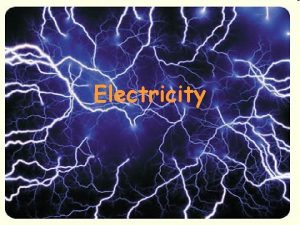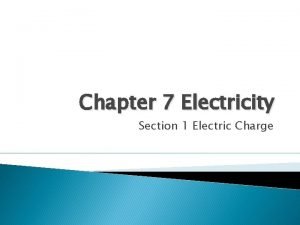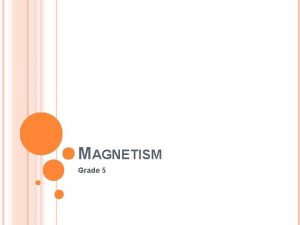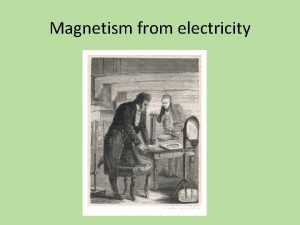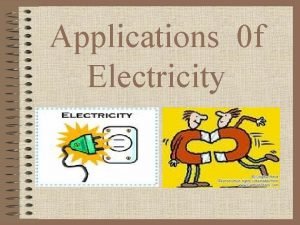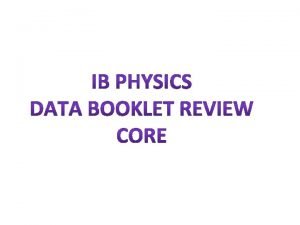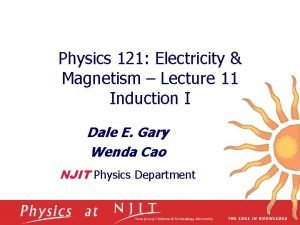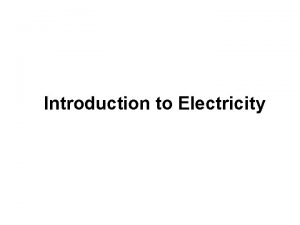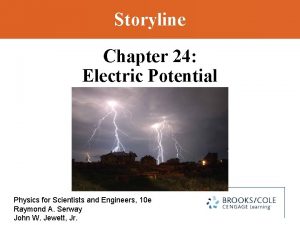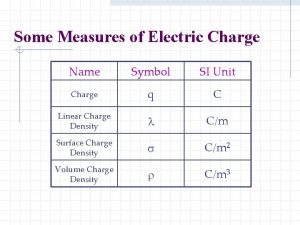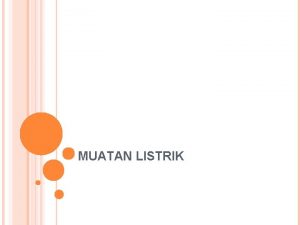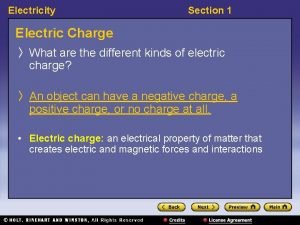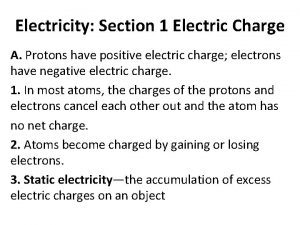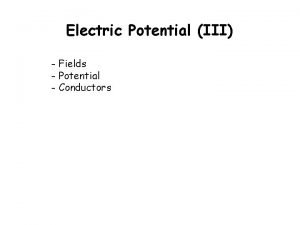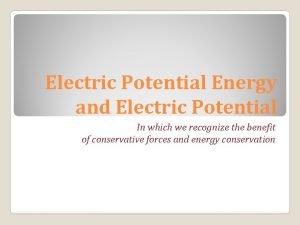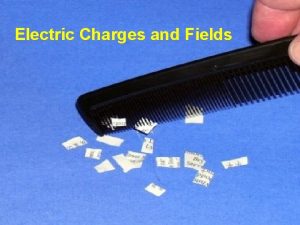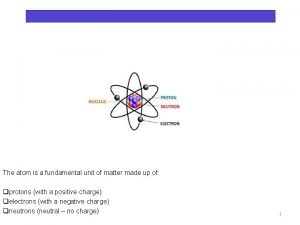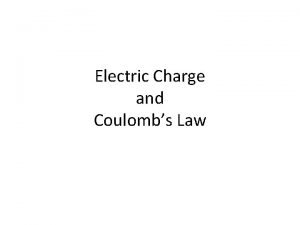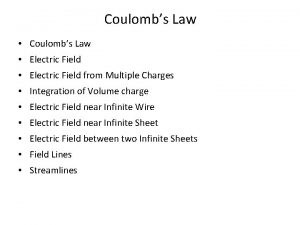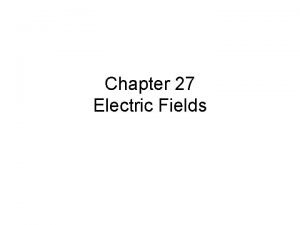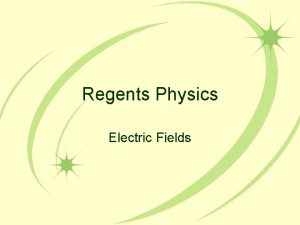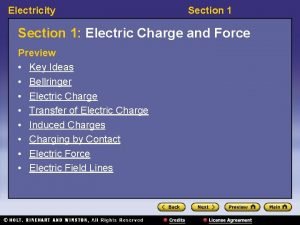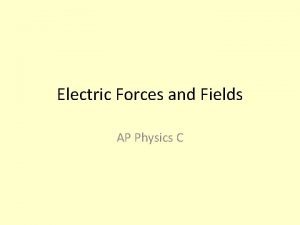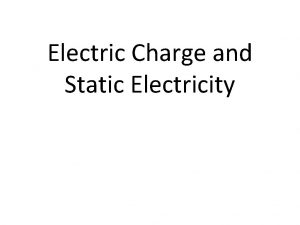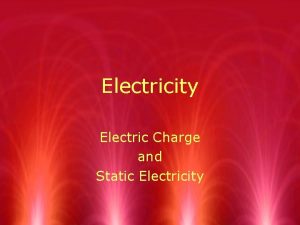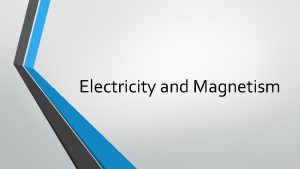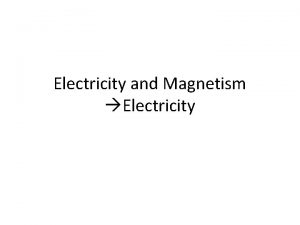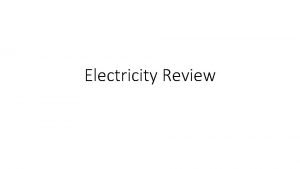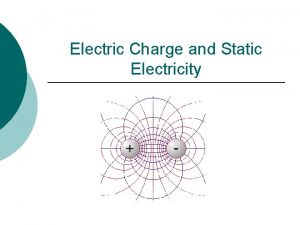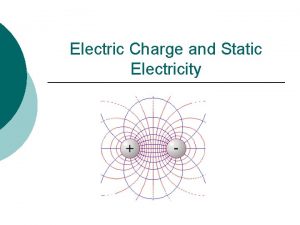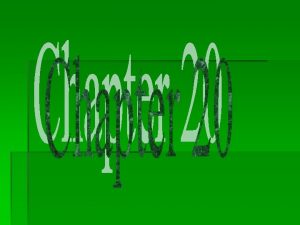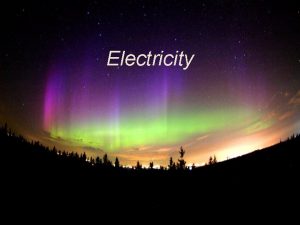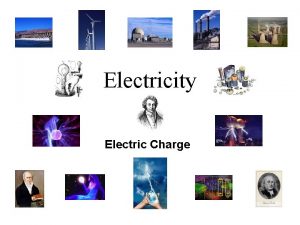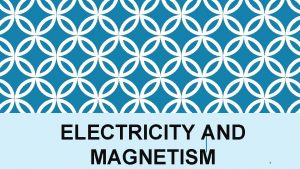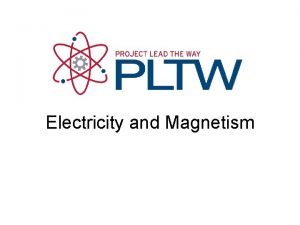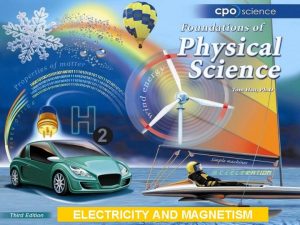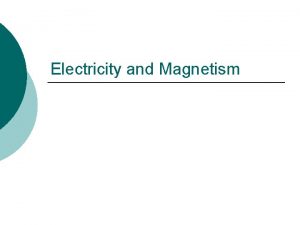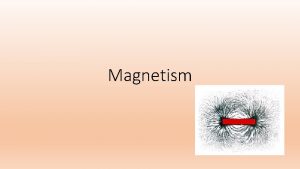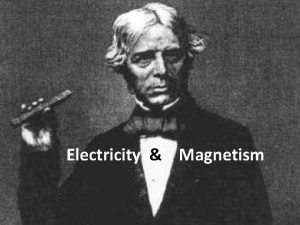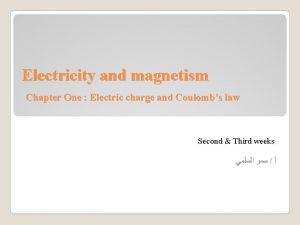Electricity And Magnetism Electricity I Electric Charge A















































- Slides: 47

Electricity And Magnetism

Electricity

I. Electric Charge A. Positive Vs Negative Charges Atoms 3 subatomic particles Protons: positive charge Electrons: Negative charge Neutrons: no charge/neutral A Protons neutral atom has equal _____ & Electrons ______ Charged Object atom must gain or lose only electrons A Protons positive atom has more _____. A negative atom has more ____. Electrons

II. Charge & Force Words to know Attraction Forces pull objects together Replusion Forces Rules Like push objects apart of Charge charges repel (+/+ or -/-) Opposite charges attract (+/-) + + + -

III. Electricity § Definition: The energy associated with charged particles as they move from place to place § Material determines how charges move through them v Conductors • Materials that allow electric charges to move easily • Metals, ions, skin v Insulators • Materials that do NOT allow electrons to flow freely • Rubber, plastic, wood, glass

IV. Forms of electricity § Static v. The accumulation of excess electric charge on an object v. Often § built up at rest Current v. The flow of electrons in a circuit

Static Electricity “AT REST” v Occurs between 2 objects that become oppositely charged v Objects involved have unequal electric charges (often negative charge is higher) § Examples v Clothes sticking together in the dryer (if no dryer sheet is used) v Hair standing up after being brushed (on days with low humidity) v Walking across the carpet and then touching something and you get shocked. §

Lightning § Massive discharge of millions of volts of static electricity (electrons transferred from a cloud to the Earth) v Friction from movement of water drops in a cloud build up positive and negative charges v Bolts can deliver 100 million volts § Safest place to be in a lightning storm is inside § Lightning rods are grounded to Earth to distribute the charge

V. Electric Current § § § Definition: The net movement of electric charges in a single direction. The FLOW of electric charges in a circuit Units = Amperes (amps) Symbol = I Speed of Current is affected by v Type, length, & thickness of wire v Voltage v If voltage increases, current increases

VI. Voltage (Potential Difference) The pushing force that makes electrons flow (electrons have potential to flow but won’t on their own) v Difference between energy levels is needed for flow § • § § § Electrons flow in a circuit when there is an energy difference from one end of the energy source to the other end of the energy source (like a battery) Units = VOLTS (v) Symbol = V (capital) Measured with a Voltmeter

VII. Types of Electric Current § § Direct Current (DC) v Electron flow is always in the same direction v Ex: Batteries Alternating Current (AC) v Electrons move back and forth reversing their direction regularly v Ex: Electricity in the Home Big Idea: How do they differ?

VIII. Resistance § Definition: The tendency for a material to resist the flow of electrons § Unit = Ohm (Ω) § Symbol = R

VIII. Resistance § Factors that affect resistance § § § What the material is The length of the material The thickness of the material Ex: Highest resistance in: v Poor conductors v Thin wires v Long wires Ex: Lowest resistance in: v v v Good conductors Thick wires Short wires

IX. Ohm’s Law § Relates Electric Current, Voltage, & Resistance v Current and Voltage are directly related (do the same) v Current and resistance are indirectly related (do the opposite) Voltage (volts) V=I*R Current (amps) Resistance (ohms)

IX. Ohm’s Law If current and voltage are directly related, what happens to the voltage when the current increases? What about when voltage decreases, what happens to the current? It also decreases If current and resistance are indirectly related, what happens to the current if the resistance decreases? It also increases It increases What about when the current decreases, what happens to the resistance? It increases

Practice Calculations § 1. Calculate the voltage across a 3 Ω resistor if a 0. 5 amp current is flowing through it Identify Variables Answer V=? R=3Ω I = 0. 5 amp Formula V= I * R Plug V= 3 * 0. 5 1. 5 volts

Practice Calculations § 2. A radio with a resistance of 240 Ω is plugged into a 120 v outlet. What is the current flowing through the outlet? Identify Variables V = 120 volts R = 240 Ω I=? Formula I= V/R Plug 120 /240 = I Answer 0. 5 amps

Practice Calculations 3. What is the resistance of a circuit with 20 V and 2 A? Identify Variables V = 20 volts R=? I = 2 Amps Formula R= V/I Plug R=20/2 Answer 10 Ohms

X. Power § RATE at which energy is flowing § The measure of the RATE at which electricity does work or provides energy § Symbol = P § Units = Watts (W) § Formula: P=I*V

Practice Calculations 4. If a CD player uses 4. 5 v with 0. 2 amp current, how much power does it use? Identify Variables Answer P=? V = 4. 5 volts I= 0. 2 amp Formula P=I*V Plug P= (0. 2) (4. 5) 2. 25 W

XI. Electrical Energy § Home use of electric energy is based on the AMOUNT OF ELECTRICAL POWER used per hour § Symbol= E § Measured in kilowatt hours (1000 Watts per hour) = k. Wh § Formula: E = P*t

Practice Calculations 5. You use your hairdryer for 20 minutes everyday. The hairdryer uses 1000 k. W. How many kilowatt-hours does your hairdryer use in 6 days? Identify Variables E=? P= 1000 k. W t= (20/60)= 2 h Formula E = P*t Plug E= 1000 * 2 Answer 2000 k. Wh

End of day 1

XII. Electric Circuit § Path for the electrons to flow § § Ex: Electricity can only flow through a CLOSED circuit not an open one Consists of a power source, wire, and a resistor (device that uses electrical energy like a light bulb) § Two types § § Series and Parallel

Symbols for Circuit Diagrams Wire Positive Side of Power Source Negative Side of Power Source Bulb Resistance Switch (open) (closed)

Open Circuit § Light will not go on because the wire IS NOT CONNECTED to the battery on both sides; current will NOT flow § Remember, electricity does not flow in an open circuit

Closed Circuit § Light bulb turns on because the electrical current CAN now flow through the complete circuit § REMEMBER: electricity can flow in a closed circuit

Series Circuit All parts of the circuit are connected one after another in a loop § There is only one path for the electrons to follow § If one part goes out § v The circuit goes from closed to open v Electricity will not flow v All parts go out The voltage is split through each part of the circuit § The current is the same throughout the circuit § Example: Christmas Tree Lights §

Series Circuit Examples A complete circuit turns the light bulbs on

Series Circuit Examples This Light Bulb is Burnt Out The burnt bulb stops the electron flow to the rest of the circuit

Parallel Circuit § § § There is more than one path or branch for the electrons If a break occurs in one branch, the electrons can still flow in the other The voltage is the same throughout each branch The current is split through each branch Example: Household Wiring

Parallel Circuit Examples A PATH #1 Current divides and has more than one path PATH #2 B

Parallel Circuit Examples A B Even though Bulb “B” is burnt out, the current still goes through the other circuit and Bulb “A” remains lit This Light Bulb is Burnt Out

XIII. Nonrenewable and Renewable Resources Used to make Electricity Nonrenewable § § Cannot be replaced by natural processes as quickly as they are used. Examples: crude oil, natural gas, coal, and uranium Coal, crude oil, and natural gas -fossil fuels (formed from the buried remains of plants and animals that lived millions of years ago. ) Uranium ore, a solid, is mined and converted to a fuel used at nuclear power plants. Renewable § Energy source that is replaced by natural processes as fast as humans consume the resource. § Examples: solar, hydroelectric, tidal, wind, geothermal, biomass


End of Day 2

Magnetism Notes

I. Magnetism A force of attraction or repulsion due to an arrangement of electrons. Forces are strongest at the poles (North and South)

II. Magnetic Properties All magnets have a north and south pole § Another name for the poles is domains. § When groups of atoms align their magnetic poles this creates the domains. § Atoms line up so all north poles face one direction & all south face the opposite direction § v. If you cut a magnet in half, it still has a north and south pole; never just one pole Bar magnet cut into three parts

II. Magnetic Properties In magnetized objects, all the north and south poles point in the SAME direction.

Opposites attract Likes repel

III. Magnets in Our Life § § § Refrigerator magnets Bar magnets Door bells Levitating trains Etch-a-Sketch & Magna Doodle toys Electromagnets are used to generate electrical power

IV. Earth as a magnet Earth is surrounded by a magnetic field. Magnetic Variation: compasses point to magnetic north, not geographical north. (smallest at equator)


V. Electromagnets Are used to generate electrical power. Uses electricity and magnets Wrap wire around a soft iron core and pass electricity through the wire. Increase strength by: Increase number of loops (wraps)—such as around a nail Increase current flow

Electric motors

VI. Electrical Devices 1. Motors: converts electrical energy into mechanical energy. 2. Generators: converts mechanical energy into electrical.
 Difference between charge and electric charge
Difference between charge and electric charge Electrons flowing
Electrons flowing Chapter 21 electric charge and electric field
Chapter 21 electric charge and electric field Chapter 21 electric charge and electric field
Chapter 21 electric charge and electric field K constant unit
K constant unit Dc o/d per item charge
Dc o/d per item charge Chapter 6 electricity section 1 electric charge answers
Chapter 6 electricity section 1 electric charge answers Section 1 electric charge crossword puzzle answers
Section 1 electric charge crossword puzzle answers Electricity section 1 electric charge
Electricity section 1 electric charge Physics 102
Physics 102 Ib physics topic 5 questions and answers
Ib physics topic 5 questions and answers Magnetism
Magnetism Electricity jeopardy
Electricity jeopardy Sph3u electricity and magnetism
Sph3u electricity and magnetism Relationship between electricity and magnetism
Relationship between electricity and magnetism Electric susceptibility formula
Electric susceptibility formula Grade 5 electricity and magnetism
Grade 5 electricity and magnetism Electricity and magnetism
Electricity and magnetism Electric fuse and circuit breaker graphic organizer
Electric fuse and circuit breaker graphic organizer Ampere
Ampere Electricity and magnetism
Electricity and magnetism Electricity and magnetism
Electricity and magnetism How are static electricity and current electricity alike
How are static electricity and current electricity alike Static electricity and current electricity
Static electricity and current electricity Electricity n
Electricity n Chapter 17 section 1 electric charge and force answer key
Chapter 17 section 1 electric charge and force answer key Charge q unit
Charge q unit Electric energy formula
Electric energy formula Electric field electric potential
Electric field electric potential Joules per coulomb
Joules per coulomb Electric charges and electric forces lesson outline
Electric charges and electric forces lesson outline Electric field of a finite line charge
Electric field of a finite line charge Unit of charge
Unit of charge What is electric charge measured in
What is electric charge measured in Electrostatics formula
Electrostatics formula Section 1 electric charge crossword puzzle answers
Section 1 electric charge crossword puzzle answers Section 1 electric charge
Section 1 electric charge Electric field of a finite line charge
Electric field of a finite line charge What is the potential at point a
What is the potential at point a What is amber in electricity
What is amber in electricity Charge on proton
Charge on proton Coulomb units
Coulomb units Electric field of infinite line
Electric field of infinite line Electric field equations
Electric field equations Properties of coulomb's law
Properties of coulomb's law Electric field lines about a point charge extend
Electric field lines about a point charge extend Section 1 electric charge
Section 1 electric charge Electric field of line charge
Electric field of line charge







